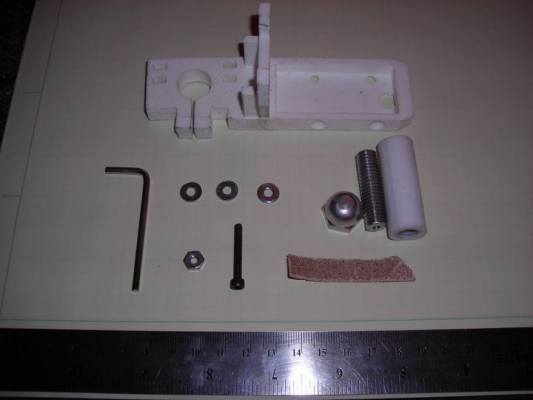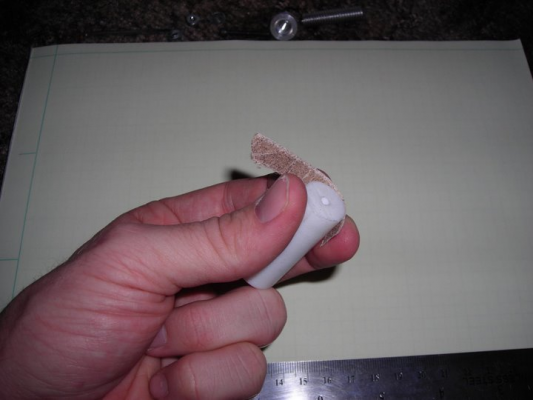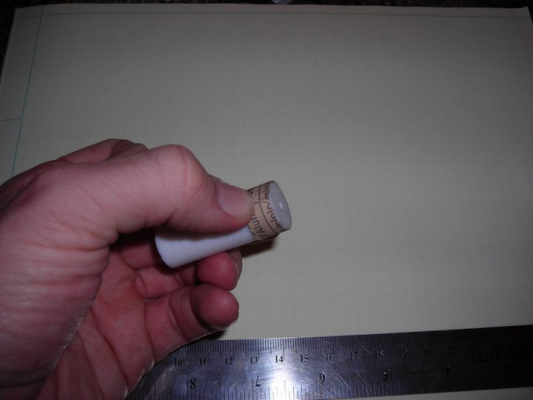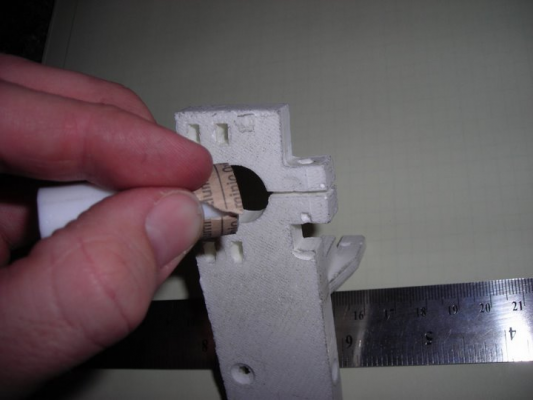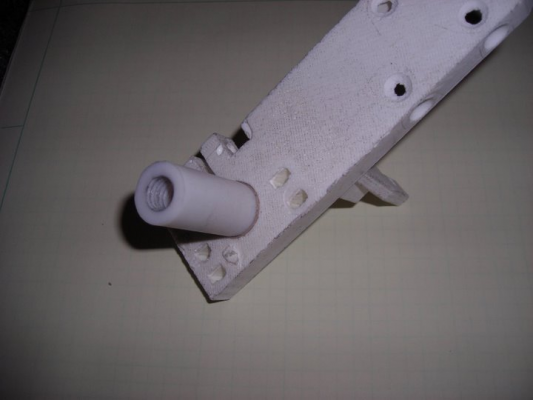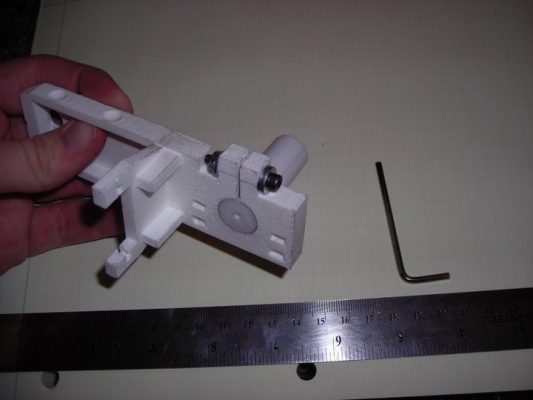Changes that need to be made to the extruder
Posted by bobt
|
Changes that need to be made to the extruder January 09, 2008 11:05PM |
Registered: 16 years ago Posts: 184 |
I have seen in other posts that there is a problem with the PTFE insulator barrel (D) coming out of the extruder housing clamp (A) because of the pressure used to force the HDPE into the melting barrel. All that is needed to correct this problem is to put a 2 mm groove in part D about 5 mm wide down 7 mm from the non-threaded end. On the part A (clamp) put a ridge inside of the barrel clamp area the is 2 mm thick and is level from the bottom and comes up 5 mm from the bottom thus creating a retaining ring in the clamp part to hold the insulator barrel. Anyway this is my 2 cents on how to solve that specific problem.
Bob Teeter
"What Box?"
Bob Teeter
"What Box?"
|
Anonymous User
Re: Changes that need to be made to the extruder January 10, 2008 10:53AM |
I agree with you. The PTFE insulator barrel needs a flange on top and that flange could even be square so that it stays put when you are changing tips. Also, the clamp would no longer be needed, thus eliminating one more metal bolt from the system.
However, as we have learned in the Houston RepRap Users Group, it is far too easy to redesign everything while you are building it. It is much better for the project to build with the design we currently have, make two more copies to give away, and then start fabricating new parts for our machines. It is better to have a thousand machines that can be upgraded quickly, then to have one perfect machine ten years from now.
Although I think this part change is something that should be considered as soon as it could speed up replication time. Then again, I would like to see a one piece direct drive feed screw instead of the multi-piece flex feed screw we have to build with JB Weld. So you see there is no limit to the changes we can make to this project before we even print the first part. As for me, I
However, as we have learned in the Houston RepRap Users Group, it is far too easy to redesign everything while you are building it. It is much better for the project to build with the design we currently have, make two more copies to give away, and then start fabricating new parts for our machines. It is better to have a thousand machines that can be upgraded quickly, then to have one perfect machine ten years from now.
Although I think this part change is something that should be considered as soon as it could speed up replication time. Then again, I would like to see a one piece direct drive feed screw instead of the multi-piece flex feed screw we have to build with JB Weld. So you see there is no limit to the changes we can make to this project before we even print the first part. As for me, I
|
Re: Changes that need to be made to the extruder January 10, 2008 12:06PM |
Admin Registered: 17 years ago Posts: 7,879 |
>I would like to see a one piece direct drive feed screw instead of the multi-piece flex feed screw we have to build with JB Weld
The older version with direct drive is here:
[reprap.org]
You should be able to build a cross between the two by changing the motor mount and the coupling to the older versions.
[www.hydraraptor.blogspot.com]
The older version with direct drive is here:
[reprap.org]
You should be able to build a cross between the two by changing the motor mount and the coupling to the older versions.
[www.hydraraptor.blogspot.com]
|
Anonymous User
Re: Changes that need to be made to the extruder January 10, 2008 12:16PM |
|
Re: Changes that need to be made to the extruder January 10, 2008 01:32PM |
Admin Registered: 17 years ago Posts: 7,879 |
It was so that stiff filament that does not bend easily can be used, I suppose it would have to be in rod form or a very large reel. It is definitely not required for CAPA or HDPE, I am not sure about PLA which is stiffer.
[www.hydraraptor.blogspot.com]
[www.hydraraptor.blogspot.com]
|
Re: Changes that need to be made to the extruder January 10, 2008 03:27PM |
Registered: 16 years ago Posts: 447 |
I suppose a single set of parts could be designed to do either, depending on how it's put together. Assemble it this way and it uses a curved drive; assemble it that way and it uses a straight drive. I expect that, once we have a few people with working machines, we'll start to see variants on the extruder popping up here and there.
|
Re: Changes that need to be made to the extruder January 10, 2008 03:35PM |
Registered: 16 years ago Posts: 235 |
I am going to eventually build an extruder that is direct drive, but it will use a tube that is threaded on the inside for pushing the filament. This will let me put a hole straight through the top of the extruder to allow for less flexible filament while still having the accuracy and durability of a direct drive system. I you would like to see a sketch, I'll scan mine upon request.
Jay
Jay
|
Re: Changes that need to be made to the extruder January 10, 2008 04:27PM |
Admin Registered: 16 years ago Posts: 13,888 |
... i'm thinkin of a direct-drive-extruder with two opposite gears which cut slightly in the filament and 'roll' it up and down ('up' when stop extruding for releasing the pressure in the melted area and avoid dropping) - this should eliminate most of the friction in the feeding too.
Only one of the feeding gears is driven by the motor, the opposite gear is a passive counter-support and runs free ...
***
Ideas for recycling plastic: - it's maybe better to build a separate filament-extruder, which melts all sorts of thermoplastics and continuously extrude a filament of the right diameter for the reprap, so you didn't have to worry about blocking the extruder-head with melted granules with the 'stop-n-go'-melting when printing.
I think there could start a sort of seeding competence- and support-centres for the reprapper-community, where some skilled persons or groups will build some sophisticated infrastructure in their basement and ship to the local or nearby reprappers.
The actual support can be handled by Zach and Ian, but when the number of users multiply, then the support should be more decentralized (what should be cheaper too)
In the next months i want build some of this stuff on my own (as i have sometimes a bit different needs then 'normal' reprappers ), so maybe i'll assist Ian in the european region and hope to interest some folks in Germany, so we can exchange locally ...
), so maybe i'll assist Ian in the european region and hope to interest some folks in Germany, so we can exchange locally ...
Viktor
Only one of the feeding gears is driven by the motor, the opposite gear is a passive counter-support and runs free ...
***
Ideas for recycling plastic: - it's maybe better to build a separate filament-extruder, which melts all sorts of thermoplastics and continuously extrude a filament of the right diameter for the reprap, so you didn't have to worry about blocking the extruder-head with melted granules with the 'stop-n-go'-melting when printing.
I think there could start a sort of seeding competence- and support-centres for the reprapper-community, where some skilled persons or groups will build some sophisticated infrastructure in their basement and ship to the local or nearby reprappers.
The actual support can be handled by Zach and Ian, but when the number of users multiply, then the support should be more decentralized (what should be cheaper too)
In the next months i want build some of this stuff on my own (as i have sometimes a bit different needs then 'normal' reprappers
 ), so maybe i'll assist Ian in the european region and hope to interest some folks in Germany, so we can exchange locally ...
), so maybe i'll assist Ian in the european region and hope to interest some folks in Germany, so we can exchange locally ...Viktor
|
Re: Changes that need to be made to the extruder January 13, 2008 08:50PM |
Registered: 16 years ago Posts: 622 |
Hi all,
I have a fix for the extruder problem. I simply used 100 grit sandpaper to add some friction to the whole mess.
I'll illustrate in a step by step manner.
I used the following parts for the extruder barrel and support assembly:
The piece of sand paper is 1 cm by 4.5 or 5 cm. It is of 100 grit but any grit about that value should work. I used a bit rougher grit first--60--but had some problems with the fit. It will be very tight as it is.
I then wrapped the sandpaper around the PTFE barrel with the grit facing in so that it will grab the plastic:
No glues or adhesives are required. The sand paper will stick quite nicely once you get it into the barrel clamp like so:
I then attached the bolts as normal and had a completed PTFE barrel with clamp:
I did a bit of testing--no hard numbers to give you--and found that I couldn't budge the PTFE barrel even with a minimum of tension on the clamp bolt. I put the thing in my bench vice and gave it a yank with no results. Thing is sturdy!
Hope that helps everyone. I still agree that we should re-design but I don't think that should happen for the official Darwin until after the v1.0 release. This works well enough and is very cheap.
Demented
I have a fix for the extruder problem. I simply used 100 grit sandpaper to add some friction to the whole mess.
I'll illustrate in a step by step manner.
I used the following parts for the extruder barrel and support assembly:
The piece of sand paper is 1 cm by 4.5 or 5 cm. It is of 100 grit but any grit about that value should work. I used a bit rougher grit first--60--but had some problems with the fit. It will be very tight as it is.
I then wrapped the sandpaper around the PTFE barrel with the grit facing in so that it will grab the plastic:
No glues or adhesives are required. The sand paper will stick quite nicely once you get it into the barrel clamp like so:
I then attached the bolts as normal and had a completed PTFE barrel with clamp:
I did a bit of testing--no hard numbers to give you--and found that I couldn't budge the PTFE barrel even with a minimum of tension on the clamp bolt. I put the thing in my bench vice and gave it a yank with no results. Thing is sturdy!
Hope that helps everyone. I still agree that we should re-design but I don't think that should happen for the official Darwin until after the v1.0 release. This works well enough and is very cheap.
Demented
|
Re: Changes that need to be made to the extruder January 14, 2008 11:05AM |
Registered: 16 years ago Posts: 182 |
Yesterday in Houston we had our second meeting where we worked on RepRap for 5+ hours... and we had two assembled extruders. There seesm to be common desire/recognition for a more robust extruder...
So I propose that the RepRap communality focus on having two supported extruder designs.
-- Darwin focused on self-replication, low cost, supported plastic materials.
-- High Performance Secondary. With emphasis on basic compatibility with the RepRap software/host.
I think this encourages everyone who wants to build two extruders... one to maintain some baseline with the project... but one for more experimental purposes.
So I propose that the RepRap communality focus on having two supported extruder designs.
-- Darwin focused on self-replication, low cost, supported plastic materials.
-- High Performance Secondary. With emphasis on basic compatibility with the RepRap software/host.
I think this encourages everyone who wants to build two extruders... one to maintain some baseline with the project... but one for more experimental purposes.
|
Re: Changes that need to be made to the extruder January 14, 2008 11:58AM |
Admin Registered: 17 years ago Posts: 1,487 |
Hey,
I definitely think its worth redesigning the extruder. There are a couple paths:
1. start redesigning the 3D parts, and hopefully be able to print them on your RepStrap. If thats impossible, we might be able to get them printed on the stratasys, molds made of them, and then cast parts distributed (however, we'd want to make sure they *really* work before we do that.
2. start working on 'hacks' that can be done to the extruder to make things work better. the sandpaper is a great start, i'm sure there are more hacks out there somewhere too.
I definitely think its worth redesigning the extruder. There are a couple paths:
1. start redesigning the 3D parts, and hopefully be able to print them on your RepStrap. If thats impossible, we might be able to get them printed on the stratasys, molds made of them, and then cast parts distributed (however, we'd want to make sure they *really* work before we do that.
2. start working on 'hacks' that can be done to the extruder to make things work better. the sandpaper is a great start, i'm sure there are more hacks out there somewhere too.
|
Re: Changes that need to be made to the extruder January 14, 2008 12:58PM |
Registered: 16 years ago Posts: 447 |
I think I can help with #1. I've got models of both the original and quick-fit extruder clamps that *should* be printable on a RepStrap (i.e. they look OK but they're untested).
I can add a ridge to the inside of the clamp. I'm thinking, say, half the height of the clamp itself, with an inside diameter of 14mm. To use, you'd need to cut a 2mm-deep groove near the end of the PTFE and snap it into place.
I can add a ridge to the inside of the clamp. I'm thinking, say, half the height of the clamp itself, with an inside diameter of 14mm. To use, you'd need to cut a 2mm-deep groove near the end of the PTFE and snap it into place.
|
Re: Changes that need to be made to the extruder January 14, 2008 01:19PM |
Admin Registered: 17 years ago Posts: 7,879 |
I am also going to design a new extruder in the next week or so. I will publish a postmortem of the old one first. Unfortunately it didn't last long enough to make its own replacement so I will convert my machine back to a milling machine to make the new experimental one.
My aim is to make it robust enough for HDPE and to get the MTBF up. It will be slightly harder to fabricate though.
[www.hydraraptor.blogspot.com]
My aim is to make it robust enough for HDPE and to get the MTBF up. It will be slightly harder to fabricate though.
[www.hydraraptor.blogspot.com]
|
Anonymous User
Re: Changes that need to be made to the extruder January 14, 2008 01:55PM |
This is great. This is the way the open source project should work. I want a longer barrel that can get hotter quicker. I will add sandpaper for now to mine and later I will try to print a barrel with a flat top flange that will have four bolt holes, and sit completely on top of the support assembly. There will be no way for this part to move even if you wanted it to.
I still have a long way to go before I mill that piece but with everyone trying something soon we will have a new, cheap, more robust extruder.
Edited 1 time(s). Last edit at 01/14/2008 01:56PM by Cheap!.
I still have a long way to go before I mill that piece but with everyone trying something soon we will have a new, cheap, more robust extruder.
Edited 1 time(s). Last edit at 01/14/2008 01:56PM by Cheap!.
|
Re: Changes that need to be made to the extruder January 14, 2008 02:44PM |
Admin Registered: 17 years ago Posts: 7,879 |
>I want a longer barrel that can get hotter quicker.
How long does it take at the moment? Mine takes 2 minutes which is nothing compared to the time it takes to make something.
Why longer?
>later I will try to print a barrel with a flat top flange.
If its printed how can it stand the temperature required?
[www.hydraraptor.blogspot.com]
How long does it take at the moment? Mine takes 2 minutes which is nothing compared to the time it takes to make something.
Why longer?
>later I will try to print a barrel with a flat top flange.
If its printed how can it stand the temperature required?
[www.hydraraptor.blogspot.com]
|
Anonymous User
Re: Changes that need to be made to the extruder January 14, 2008 04:29PM |
nophead,
I was having issues with room temp. in my garage yesterday. Insulation would help but I would like a little more thermal mass to keep the temps where they should be during printing. (Not that I'm ready to print yet)
I see now I will have to mill down a block to make that barrel part I want. I should be able to just drop it in the same support assembly and just run the bolts through the "guide tee," then through it, and then through the support assembly all at the same time.
If I could make a dremel attachment on my McWire, I may be able to program it to mill the part I need.
I was having issues with room temp. in my garage yesterday. Insulation would help but I would like a little more thermal mass to keep the temps where they should be during printing. (Not that I'm ready to print yet)
I see now I will have to mill down a block to make that barrel part I want. I should be able to just drop it in the same support assembly and just run the bolts through the "guide tee," then through it, and then through the support assembly all at the same time.
If I could make a dremel attachment on my McWire, I may be able to program it to mill the part I need.
|
Re: Changes that need to be made to the extruder January 14, 2008 05:52PM |
Admin Registered: 17 years ago Posts: 7,879 |
I think higher thermal mass is probably a bad thing. The temperature should be held constant by the feedback loop rather than stored heat. With the simple on off control I use the thermal mass determines the amount of overshoot / under shoot. I only get about +- 3C but I probably have a bit less mass than the acorn nut version.
Higher thermal mass would make it overshoot and undershoot more I think.
PTFE is very soft so you may well be able to mill it with the McWire and a Dremel, good luck.
[www.hydraraptor.blogspot.com]
Higher thermal mass would make it overshoot and undershoot more I think.
PTFE is very soft so you may well be able to mill it with the McWire and a Dremel, good luck.
[www.hydraraptor.blogspot.com]
|
Anonymous User
Re: Changes that need to be made to the extruder January 14, 2008 06:02PM |
|
Re: Changes that need to be made to the extruder January 14, 2008 06:55PM |
Admin Registered: 17 years ago Posts: 7,879 |
I am using a 10K thermistor with 470R in parallel to make it approximately linear over the range 25C to 250C. I then measure the voltage with a 10 bit A/D converter and compare it to the target value to decide if the heater should be on or off.
Full details here: [hydraraptor.blogspot.com].
Both the old hardware and Zach's new hardware should be able to achieve the same accuracy using a 100K thermistor with 4K7 in parallel.
[www.hydraraptor.blogspot.com]
Full details here: [hydraraptor.blogspot.com].
Both the old hardware and Zach's new hardware should be able to achieve the same accuracy using a 100K thermistor with 4K7 in parallel.
[www.hydraraptor.blogspot.com]
|
Re: Changes that need to be made to the extruder January 17, 2008 04:26AM |
Registered: 16 years ago Posts: 270 |
I think the PTFE barrel coming out of the clamp is down to manufacturing tolerance I have tested my extruder dead headed and chew the filament to shreds with no slipage of the insulator, that being said I make the OD 16.5mm which is a gentle push into the clamp. What is the OD of your insulators as plastic stock has a massive manufacturing tolerance often +-0.5mm or more i.e. 16mm
Ian
[www.bitsfrombytes.com]
Ian
[www.bitsfrombytes.com]
|
Re: Changes that need to be made to the extruder January 17, 2008 05:38AM |
Admin Registered: 17 years ago Posts: 7,879 |
My clamp is milled from Delrin and was a perfect interference fit with the PTFE before the screw was tightened. Early on it got spat out so I tightened it a lot more and it held ever since. But, PTFE creeps, so when I look at it now the top end of the PTFE tube has reduced in diameter and so has the hole in the middle so it is a tight fit on the filament.
I think the problem at the other end is again down to PTFE creep. The thread held for months but finally let the nozzle jump a few threads. HDPE had managed to flow all the way down the thread and appear at the top of the nozzle. The thread was a good fit but I think the PTFE swells when subjected to pressure for a long time.
The wikipedia entry for PTFE talks about it creeping so I think the pipe clip at the bottom end is a good idea and the top needs to be secured by something other than a friction clamp. After all, PTFE is the most slipery substance known to man I think.
[www.hydraraptor.blogspot.com]
I think the problem at the other end is again down to PTFE creep. The thread held for months but finally let the nozzle jump a few threads. HDPE had managed to flow all the way down the thread and appear at the top of the nozzle. The thread was a good fit but I think the PTFE swells when subjected to pressure for a long time.
The wikipedia entry for PTFE talks about it creeping so I think the pipe clip at the bottom end is a good idea and the top needs to be secured by something other than a friction clamp. After all, PTFE is the most slipery substance known to man I think.
[www.hydraraptor.blogspot.com]
|
Re: Changes that need to be made to the extruder January 17, 2008 10:33AM |
Registered: 16 years ago Posts: 184 |
Gentlemen - Back to my original issue - the cure is to create a 2mm lip on the outside of the barrel and a matching relief in the clamp so that there is an edge to carry the pressure load and not just a grab of the barrel to hold it. Both changes can be made by using a barrel 4 mm greater and machining off all but the lip and forming the clamp creating the recess. This is really very simple engineering to do. With this change is it even necessary to have the clamp and simply having a slip fit just like they do in plumbing under you sink everyday.
Bob Teeter
"What Box?"
Bob Teeter
"What Box?"
|
Re: Changes that need to be made to the extruder January 17, 2008 11:49AM |
Registered: 16 years ago Posts: 447 |
|
Re: Changes that need to be made to the extruder January 17, 2008 12:25PM |
Admin Registered: 17 years ago Posts: 7,879 |
I can see pros and cons with both approaches:
With a groove you have to split the clamp in two to get it in unless it is very shallow. However, you can still turn it to any position and then lock it allowing you to line up the heater wires (when you screw the nozzle in you can't predict the point where it will stop turning).
Perhaps a hexagonal head solves that but its starting to get harder to make.
Perhaps Steve's mod with the two self tapping screws is actually the best solution. If they intrude into the hole the right amount they should be sufficient to hold.
I will probably run with the groove and a two part clamp. Half of the clamp will be the end of my pump body. The other half a bridge shape the bolts to it. That gets rid of the horizontal base completely making it easier to mount on a machine with a z-axis like mine.
[www.hydraraptor.blogspot.com]
With a groove you have to split the clamp in two to get it in unless it is very shallow. However, you can still turn it to any position and then lock it allowing you to line up the heater wires (when you screw the nozzle in you can't predict the point where it will stop turning).
Perhaps a hexagonal head solves that but its starting to get harder to make.
Perhaps Steve's mod with the two self tapping screws is actually the best solution. If they intrude into the hole the right amount they should be sufficient to hold.
I will probably run with the groove and a two part clamp. Half of the clamp will be the end of my pump body. The other half a bridge shape the bolts to it. That gets rid of the horizontal base completely making it easier to mount on a machine with a z-axis like mine.
[www.hydraraptor.blogspot.com]
|
Re: Changes that need to be made to the extruder January 17, 2008 03:43PM |
Registered: 16 years ago Posts: 622 |
Hi,
Since we need a thermal barrel that can stand more heat anyway--extruding aluminum--why not make the next design iteration out of a different material all together? I'm thinking some sort of ceramic. Easy to mold and form, easy to fire locally--most towns, in the US at least, have a kiln--and very cheap. It will stand up to massive temperatures and provides a good bit of insulation if not all we would hope for. If it doesn't provide enough insulation, we can use it as a base and layer on other material afterwards to achieve what we need.
Demented
Since we need a thermal barrel that can stand more heat anyway--extruding aluminum--why not make the next design iteration out of a different material all together? I'm thinking some sort of ceramic. Easy to mold and form, easy to fire locally--most towns, in the US at least, have a kiln--and very cheap. It will stand up to massive temperatures and provides a good bit of insulation if not all we would hope for. If it doesn't provide enough insulation, we can use it as a base and layer on other material afterwards to achieve what we need.
Demented
|
Re: Changes that need to be made to the extruder January 17, 2008 03:59PM |
Admin Registered: 16 years ago Posts: 13,888 |
|
Re: Changes that need to be made to the extruder January 17, 2008 04:02PM |
Registered: 16 years ago Posts: 622 |
|
Re: Changes that need to be made to the extruder January 17, 2008 04:30PM |
Admin Registered: 16 years ago Posts: 13,888 |
Hi Demented,
... before selecting soapstone i tried some other ceramic- and fibre-materials designed for CNC-milling too, but soapstone was in the end the best and cheapest for my project
Another possibility are elastic pre-ceramic-tapes as used for ceramic 3D-packages - look here: [www.via-electronic.de]
We assemble some LTCC-sensors custom-fabbed by VIA and i have some samples of different pre-ceramic-tapes -- light- to dark-blue sheets, bendable as stiff resin, but would brake, if bended over a sharp edge.
I can:
- cut it with a knife or scissors, mill or drill or carve it
- bend the thinner sheets with a radius of some millimeters
- print metall-paste for pads and trays on it
- print and insert vias for interlayer-conection
- stack slices and fix them with a ceramic adhesive or waterglass.
When ready, fire it in an oven at 900
Edited 1 time(s). Last edit at 01/17/2008 04:46PM by Viktor Dirks.
... before selecting soapstone i tried some other ceramic- and fibre-materials designed for CNC-milling too, but soapstone was in the end the best and cheapest for my project

Another possibility are elastic pre-ceramic-tapes as used for ceramic 3D-packages - look here: [www.via-electronic.de]
We assemble some LTCC-sensors custom-fabbed by VIA and i have some samples of different pre-ceramic-tapes -- light- to dark-blue sheets, bendable as stiff resin, but would brake, if bended over a sharp edge.
I can:
- cut it with a knife or scissors, mill or drill or carve it
- bend the thinner sheets with a radius of some millimeters
- print metall-paste for pads and trays on it
- print and insert vias for interlayer-conection
- stack slices and fix them with a ceramic adhesive or waterglass.
When ready, fire it in an oven at 900
Edited 1 time(s). Last edit at 01/17/2008 04:46PM by Viktor Dirks.
|
Re: Changes that need to be made to the extruder January 17, 2008 05:16PM |
Admin Registered: 17 years ago Posts: 7,879 |
I had an idea a while ago to use the ceramic insulator out of a spark plug. I drilled out the metal core, which was not easy. While I was doing so, I noticed how hot the whole thing got so I decided it was not a good heat insulator and abandoned the idea.
Whatever we use needs to be strong against stretching and a very good insulator. If we have molten AL at 700C at one end and a CAPA extruder body with a melting point of 60C at the other, we may need a heatsink at the cold end and perhaps PTFE as a secondary insulator.
Does talc fit the bill? Is it strong enough to withstand the extrusion pressure?
Edit:
I just read that you can fire soapstone so maybe in the fired for it would be hard enough.
Edited 1 time(s). Last edit at 01/17/2008 05:59PM by nophead.
[www.hydraraptor.blogspot.com]
Whatever we use needs to be strong against stretching and a very good insulator. If we have molten AL at 700C at one end and a CAPA extruder body with a melting point of 60C at the other, we may need a heatsink at the cold end and perhaps PTFE as a secondary insulator.
Does talc fit the bill? Is it strong enough to withstand the extrusion pressure?
Edit:
I just read that you can fire soapstone so maybe in the fired for it would be hard enough.
Edited 1 time(s). Last edit at 01/17/2008 05:59PM by nophead.
[www.hydraraptor.blogspot.com]
|
Re: Changes that need to be made to the extruder January 17, 2008 07:33PM |
Registered: 16 years ago Posts: 235 |
If you go the ceramics route, firing the clay removes most of the water, which causes major shrinkage. My grandmother was/is a professional potter, and she says that clay can shrink up to 20% to 25%!!! if the center diameter for the filament is going to need to be exact, firing clay most likely wont work. If there is a way to figure out how to do this, then I know that glazing the pottery is a great insulator. It works the same way those awesome two-layer glass tea mugs work to dissipate the heat.
Jay
Jay
Sorry, only registered users may post in this forum.
